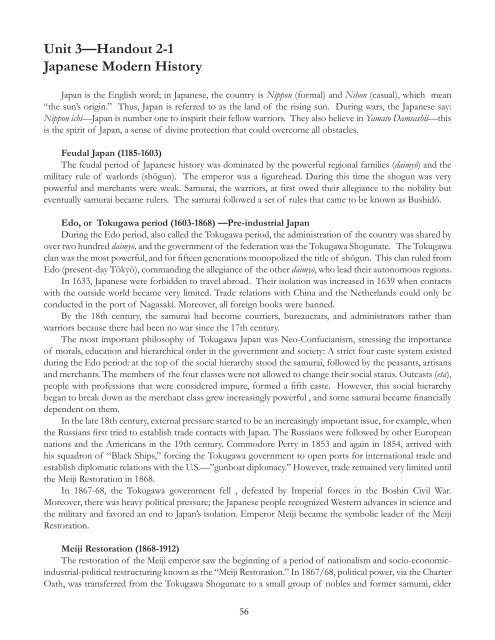Download - Canada ALPHA
Download - Canada ALPHA
Download - Canada ALPHA
You also want an ePaper? Increase the reach of your titles
YUMPU automatically turns print PDFs into web optimized ePapers that Google loves.
Unit 3—Handout 2-1<br />
Japanese Modern History<br />
Japan is the English word; in Japanese, the country is Nippon (formal) and Nihon (casual), which mean<br />
“the sun’s origin.” Thus, Japan is referred to as the land of the rising sun. During wars, the Japanese say:<br />
Nippon ichi—Japan is number one to inspirit their fellow warriors. They also believe in Yamato Damsashii—this<br />
is the spirit of Japan, a sense of divine protection that could overcome all obstacles.<br />
Feudal Japan (1185-1603)<br />
The feudal period of Japanese history was dominated by the powerful regional families (daimyō) and the<br />
military rule of warlords (shōgun). The emperor was a fi gurehead. During this time the shogun was very<br />
powerful and merchants were weak. Samurai, the warriors, at fi rst owed their allegiance to the nobility but<br />
eventually samurai became rulers. The samurai followed a set of rules that came to be known as Bushidō.<br />
Edo, or Tokugawa period (1603-1868) —Pre-industrial Japan<br />
During the Edo period, also called the Tokugawa period, the administration of the country was shared by<br />
over two hundred daimyō, and the government of the federation was the Tokugawa Shogunate. The Tokugawa<br />
clan was the most powerful, and for fi fteen generations monopolized the title of shōgun. This clan ruled from<br />
Edo (present-day Tōkyō), commanding the allegiance of the other daimyō, who lead their autonomous regions.<br />
In 1633, Japanese were forbidden to travel abroad. Their isolation was increased in 1639 when contacts<br />
with the outside world became very limited. Trade relations with China and the Netherlands could only be<br />
conducted in the port of Nagasaki. Moreover, all foreign books were banned.<br />
By the 18th century, the samurai had become courtiers, bureaucrats, and administrators rather than<br />
warriors because there had been no war since the 17th century.<br />
The most important philosophy of Tokugawa Japan was Neo-Confucianism, stressing the importance<br />
of morals, education and hierarchical order in the government and society: A strict four caste system existed<br />
during the Edo period: at the top of the social hierarchy stood the samurai, followed by the peasants, artisans<br />
and merchants. The members of the four classes were not allowed to change their social status. Outcasts (eta),<br />
people with professions that were considered impure, formed a fi fth caste. However, this social hierarchy<br />
began to break down as the merchant class grew increasingly powerful , and some samurai became fi nancially<br />
dependent on them.<br />
In the late 18th century, external pressure started to be an increasingly important issue, for example, when<br />
the Russians fi rst tried to establish trade contacts with Japan. The Russians were followed by other European<br />
nations and the Americans in the 19th century. Commodore Perry in 1853 and again in 1854, arrived with<br />
his squadron of “Black Ships,” forcing the Tokugawa government to open ports for international trade and<br />
establish diplomatic relations with the U.S.—”gunboat diplomacy.” However, trade remained very limited until<br />
the Meiji Restoration in 1868.<br />
In 1867-68, the Tokugawa government fell , defeated by Imperial forces in the Boshin Civil War.<br />
Moreover, there was heavy political pressure; the Japanese people recognized Western advances in science and<br />
the military and favored an end to Japan’s isolation. Emperor Meiji became the symbolic leader of the Meiji<br />
Restoration.<br />
Meiji Restoration (1868-1912)<br />
The restoration of the Meiji emperor saw the beginning of a period of nationalism and socio-economicindustrial-political<br />
restructuring known as the “Meiji Restoration.” In 1867/68, political power, via the Charter<br />
Oath, was transferred from the Tokugawa Shogunate to a small group of nobles and former samurai, elder<br />
56


